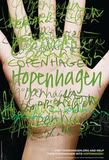Families. Everyone has one. Families come in all shapes and sizes and provide the basic foundation from which one will form his or her first relationships that affect how one will live. Several different types of families exist. The traditional family, also known as the nuclear family, is characterized by two parents and their children. One popular belief is that the nuclear family unit is not a necessary and integral part in today’s society. Everyday young people are told through their classes in school, movies, and television programs that the nuclear family is negatively traditional and exclusive of other types of families, such as single parent families and homosexual families. In the modern world, influential institutions and media, such as schools and television shows, have a major impact in shaping American youth’s understanding of themselves, the world, and the idea of family.
The ideas and images of family which are communicated through the classroom and media, not only influence the actions of individuals; they have a profound influence on public policy which, in turn, further affects daily life and decisions. The main audience for these ideas is the current generation of youth, as they are exposed to these influences on a daily basis. The picture of the ideal family has been transformed throughout the years, as through educational curriculum and popular media from the 1950’s to today.
One major impetus for the change in the family was Karl Marx. Marx was the revolutionary thinker whose ideas gave rise to communism. Marx, along with other revolutionaries, saw “the destruction of the family as the first step in the achievement of his goals. The family is key to passing the social, cultural, and religious ideals of the established order on to the next generation” (Marx and the family). Marx saw families as institutions that would curb antisocial behavior and block radical changes. He also saw the family as the means by which the establishment defended what he called "outmoded" and "oppressive" ideas (Marx and the family). Another component in the evolution of family ideals is the theory of secular humanism, which has been assimilated into the educational spheres in America. Over the years, the gradual integration of Marxist theory and secular humanism has slowly transformed the characteristics of the nuclear family through the media of education, movies, and television. The majority of the curriculum, movies, and TV shows are created for younger audiences because it is easier to integrate ideas into the youth than it is in adults, and the youth are the generation of the future.
Through the decades, the curriculum in schools has undergone major changes to accommodate the transforming family ideals. In order to not offend anyone who does not come from a traditional family, schools have exchanged their old textbooks that only portrayed nuclear families for new books that include “non-traditional” families. Schools today follow the example of secular humanism for their curriculum for students. As Steve Hall laments,
“Secular Humanists prefer to think of ‘family’ in larger groups of perhaps unrelated people. Many
secular humanists would affirm the legitimacy of same-sex marriages or civil unions. Many would
deny the importance of fathers, encouraging ‘single parenting by choice.’ Many secular humanists
trust schools more than parents to know what is best for children. Some humanists believe that the
child’s first responsibility is to a representative of the state, not necessarily to the parents. For
example, humanists often support the right of a child to an abortion without parental consent”
(Hall).
One pillar of secular humanism is tolerance. Children are now taught to always be tolerant of other religions, cultures, and different family types. For example, a required middle school textbook is an illustrated book entitled Heather Has Two Mommies.

In Heather Has Two Mommies, first published in 1989, a young girl is raised by her lesbian parents. In one of Heather’s play groups, her family situation is discussed simply and positively. Another example of the assimilation of a non-traditional familial ideal is the children’s book Daddy’s Roommate.

Daddy's Roommate was one of the first children's books to portray homosexuality in a positive light. The two men in the book do the same things heterosexual couples do: take care of the house, argue, and spend time with their boy. Through books such as these, children are exposed to alternative family lifestyles and are indoctrinated with the idea of tolerance. Secular humanism teaches that values, morals, and ethics are determined by each person for him or herself. Therefore, to tell someone else that their behavior is “wrong” or “sinful” is considered to be intolerant. Ironically, “intolerance”, defined this way, is not tolerated. It is easy to see that secular humanism has permeated into schools across the country teaching its “tolerance” agenda. According to James C. Dobson and Gary L. Bauer, “The secular humanistic system of values has now become the predominant way of thinking in most of the power centers of society, including universities, entertainment industry, and the media” (Noebel). From English and history classes to film classes, secular humanism is integrated into the fabric of the curriculum. The curriculum usually focuses on the differences between the “oppressiveness” of the traditional family with the “freedom” of the non-traditional family. At one time, the nuclear family was the norm and ideal; however, contemporary society now regards the family unit as oppressive towards women and antiquated in values. Teachers in schools and universities no longer teach pure academia, but rather teach more from their political bias. By doing this, teachers are violating established principles of academic freedom that dates back to 1915. These principles, which were developed by the American Association of University Professors, have been incorporated by American colleges into their respective “official faculty guidelines” (Horowitz, xli). For example, the University of California’s Academic Personnel Manual, which was written in 1934, states:
The function of the university is to seek and to transmit knowledge and to train students in the processes whereby truth is to be made known. To convert, or to make converts, is alien and hostile to this dispassionate duty. Where it becomes necessary, in performing this function of a university, to consider political, social, or sectarian movements, they are dissected and examined, not taught, and the conclusion left, with no tipping of the scales, to the logic of the facts…Essentially the freedom of a university is the freedom of competent persons in the classroom. In order to protect this freedom, the University assumed the right to prevent exploitation of its prestige by unqualified persons or by those who would use it as a platform for propaganda (Horowitz, xli).
This clause should have been adhered to in order to protect real tolerance in the classrooms, but on July 30, 2003, the excerpt was removed from Berkeley’s personnel manual. It was replaced with a passage that stated academic standards would now be under the responsibility of the Academic Senate. Other universities had similar clauses as Berkeley’s 1934 passage. These guidelines are based on a liberal philosophy of education, which means that the professional responsibility of educators is to elevate students’ ability to think and to not give them the correct opinions. Many professors; however, disregard these responsibilities. Marxism and secular humanism both rest on the dissolution of the nuclear family. These two theories also happen to be deeply knit into the core of curriculum in schools and universities. The ideas that the nuclear family is no longer sacred, unnecessary, and irrelevant are taught on a daily basis and each new generation that graduates from these schools and universities is equipped with this knowledge. As Engels, Karl Marx’s colleague, once said “If you could remove a people from their roots, they could be easily swayed to your point of view” (Rice).The educational sphere has become saturated with Marxism and secular humanism.
Another medium in which Marxists and secular humanists use to indoctrinate the public is the through the media, especially television shows. When television was introduced into American society, critics and journalists predicted that the invention of television would bring families together. Authors, critics, and advertisers all presented the image of television through articles and photographs "showing a family cozily sitting together before the TV set, Sis on Mom's lap, Buddy perched on the arm of Dad's chair, Dad with his arm around Mom's shoulder" (Winn, 258). In the early days of television, popular TV shows were Father Knows Best, Leave it to Beaver, and Ozzie and Harriet.

These programs illustrated the traditional family of married parents –the father going off to work and the mother staying home to care for the home and the children. These shows also portrayed traditional family values such as respect for authority, division of labor and possessions, hard work, independent thought and conversational skills, and healthy problem resolution. However, the original vision of family unity and the education of family values brought about by television would eventually be replaced by ideas that would fragment the family. "Who could have guessed that twenty or so years later, Mom would be watching a drama in the kitchen, the kids would be looking at cartoons in their room, while Dad would be taking in the ballgame in the living room?" (Winn, 258). Television, influenced by the cultural changes brought upon the family, has strayed far from those programs that have encouraged family values. Over the past fifty years, the family has been affected by the "steadily rising divorce rate, the increase in the number of working mothers, the decline of the extended family, the breakdown of neighborhoods and communities, and the growing isolation of the nuclear family" (Winn, 264). Television has not only reflected these cultural trends, but it has also contributed to them through programming that is no longer appropriate for family viewing. Therefore, television is anti-family because it undermines family values, it popularizes dysfunction in families, and it detracts from quality time that the family spends together.
The television has become a prime factor in the breakdown of family values in a home, such as communication, obedience, respect, and a constructive use of time. Marie Winn, in her essay entitled "Television: The Plug-In Drug" describes the impact of television in the life of a family. "In its effect on family relationships, in its facilitation of parental withdrawal from an active role in the socialization of their children, and in its replacement of family rituals and special events, television has played an important role in the disintegration of the American family" (Winn, 264). This influential medium affects the relationships of family members in their ability to trust and feel emotionally secure. TV also sabotages the parents' role of teaching, nurturing, and delighting in their children because it becomes the teacher, the babysitter, and the entertainer of their children. Family interaction is no longer a valued event in a home and the constant "stream of television images" has taken its place. "As family ties grow weaker and vaguer, as the children's lives become more separate from their parents', as parent's educational role in their children's lives is taken over by television and schools, family life becomes increasingly more unsatisfying for both parents and children. All that seems to be left is Love, an abstraction that family members know is necessary but find great difficulty giving each other because the traditional opportunities for expressing love within the family have been reduced or destroyed" (Winn 265). By deducting family values from a home through the presence of television, a family loses its identity that can only be realized through shared experiences and valued family time. In Barker, Cantor argues that domestic drama on television is “primarily a morality play about how we should live. In particular it seeks to inform us about how to bring up children and about what constitutes appropriate love relationships” (Barker, 49).
Furthermore, television is anti-family because it popularizes dysfunction rather than normalcy in families. Today's television programs such as Jerry Springer, Jenny Jones, and Sally, are shows that attract their audiences through dysfunctional families, who are willing to exploit themselves in the name of television. In Wendy Kaminer's essay, "Testifying: Television", the author writes about talk shows and reality programs that publicize and magnify family problems. These television programs are choosing to focus on the pathological problems of dysfunctional families. "On Geraldo, a recovering sex addict shares a story of incest—she was raped by her father and stepfather; her husband and children are seated next to her on the stage. This is family therapy" (Mandell, 332). In real life, a family such as this one would be an abomination to society. But being viewed as entertainment, this family scenario is an acceptable one. The author gives another example of television's exploitation of the family. She writes that on the Opera Winfrey Show, "…there are fathers who sleep with their sons' girlfriends (or try to), sisters who sleep with their sisters boyfriends, women who sleep with their best friends' sons, women who sleep with their husbands' bosses (to help their husbands get ahead), men who hire only pretty women, and men and women who date only interracially" (Mandell, 333-334). Millions of television watchers daily view such scenarios of unstable and unhealthy families broadcasting their pathological problems. Since these shows are airing only dysfunctional families, the importance of these families seem to be elevated above "normal" nuclear families.
And finally, television is anti-family because it detracts from the quality time that a family spends together. In her essay, Marie Winn describes how television reduces the time and experiences a family shares. "By its domination of the time families spend together, it destroys the special quality that distinguishes one family from another, a quality that depends to a great extent to what a family does, what special rituals, games, recurrent jokes, familiar songs, and shared activities it accumulates" (Winn, 259). Simply, the availability of the television in the home of a family endangers the family life. Instead of creating memorable moments, as families did in the Victorian era by playing games and sharing plentiful meals (Winn, 260), today's family watches television to pass time, and grows apart as a result. Marie Winn argues that "If the family does not accumulate its backlog of shared experiences, shared everyday experiences that occur and recur and change and develop, then it is not likely to survive as anything other than a caretaking institution" (Winn, 261). Family rituals are also becoming seemingly rare in the television-watching home. Winn tells a story of a young girl who grew up in Chicago, surround by "millions of relatives". Before television interrupted her loving, family-filled world as she knew it, she recalls how "wonderful it (life) used to be". During the holidays, her multitude of relatives would come over, and she would play with her "thousands of cousins". "All the women would be in the front of the house, drinking coffee and talking, all the men would be in the back of the house, drinking and smoking, and all the kids would be all over the place, playing hide and seek" (Winn, 261). Then she remembers a sudden change and noticed, "…how different everything had become. The kids were no longer playing Monopoly or Clue or the other games we used to play together. It was because we had a television set which had been turned on for a football game" (Winn, 262). The act of watching television may seem unharmful while involved in it, but over time, the accumulation of hours clocked in front of the TV will amount to not only hours of wasted time, but it will also represent the experiences and memories that a family will never be able to share. Television is the most widely accessible source of mass media. As Thompson notes in Barker, “We must not lose sight of the fact that, in a world increasingly permeated by the products of media industries, a major new arena has been created for the process of self-fashioning. It is an arena which is severed from the spatial and temporal constraints of face-to-face interaction, and given the accessibility of television and its global expansion, is increasingly available to individuals world-wide” (Barker, 315). This shows that through television, the breakdown of the family is not exclusively occurring in America, but internationally as well.
In conclusion, academia and television shows remain two of the most important proponents of Marxist and secular humanist values that undermine traditional family values. Schools and the media are provided with a captive audience whom they are able to influence on a daily level. Marxism and secular humanism treat the family structure as a process of continuing change, resulting in changes applied to curriculum and media concerning how the family is portrayed. The traditional family model is slowly moving toward the definition of a radical romance. A nuclear family should not be considered “radical”, but in contemporary society, it is becoming more common that a non-traditional family is considered normal. The divorce rate is now at fifty percent among all marriages, which shows that popular culture has lost respect for the family institution. This loss of respect can directly be correlated to the curriculum in schools and the ideas and images from TV shows. I was homeschooled from kindergarten through twelfth grade. Since I have been in college, I have noticed a stark difference between the curriculum I had in my homeschool years and the curriculum I have now. I have always been taught that the family acted as the base from which one learned the basic principles to live life. In my classes in college; however, I am being taught that parents are irrelevant and society is a better teacher of life’s lessons. I also remember a time when my family did not own a television. Someone might think that life without a TV would be boring, but I cherish the memories of playing games with my family when we still did not have a TV. I have been noticing for some time the lack of respect for the concept of the nuclear family. When I researched this phenomenon, I discovered that Marxism and secular humanism were at the core of the movement to disregard the sanctity of family.
Works Cited
Barker, Chris. Cultural Studies: Theory and Practice. 3rd ed. Los Angeles: Sage
Publications, 2008.
Hall, Steve. “Secular Humanism”. Abounding Joy!. 2005. Accessed December 3, 2009.
http://www.aboundingjoy.com/humanism_chart.htm
Horowitz, David. The Professors. Washington, D.C. Regnery Publishing, Inc. 2006.
Mandell, Stephen. The Blair Reader. 3rd ed. Upper Saddle River, NJ: Prentice Hall,1999. pages 332-342.
"Marx and the family”. Canada and the World Backgrounder. Taylor Publishing
Consultants Limited. 1997. HighBeam Research. Accessed December 3, 2009.
http://www.highbeam.com.
Noebel, David. “The Worldviews of Destruction in the 20th Century”. 2000. Accessed
December 6, 2009.
http://www.summit.org/resources/essays/2008/01/the_worldviews_of_destructio.php
Rice, Larry. "John Dewey, Father of Modern Education." Father of Modern Education.
2008. Web. Dececmber 10, 2009. http://www.christianparents.com/jdewey.htm
Winn, Marie. The Plug-In Drug. Television, Computers, and Family Life. New York,
New York: Viking Penguin, Inc., 2002.









